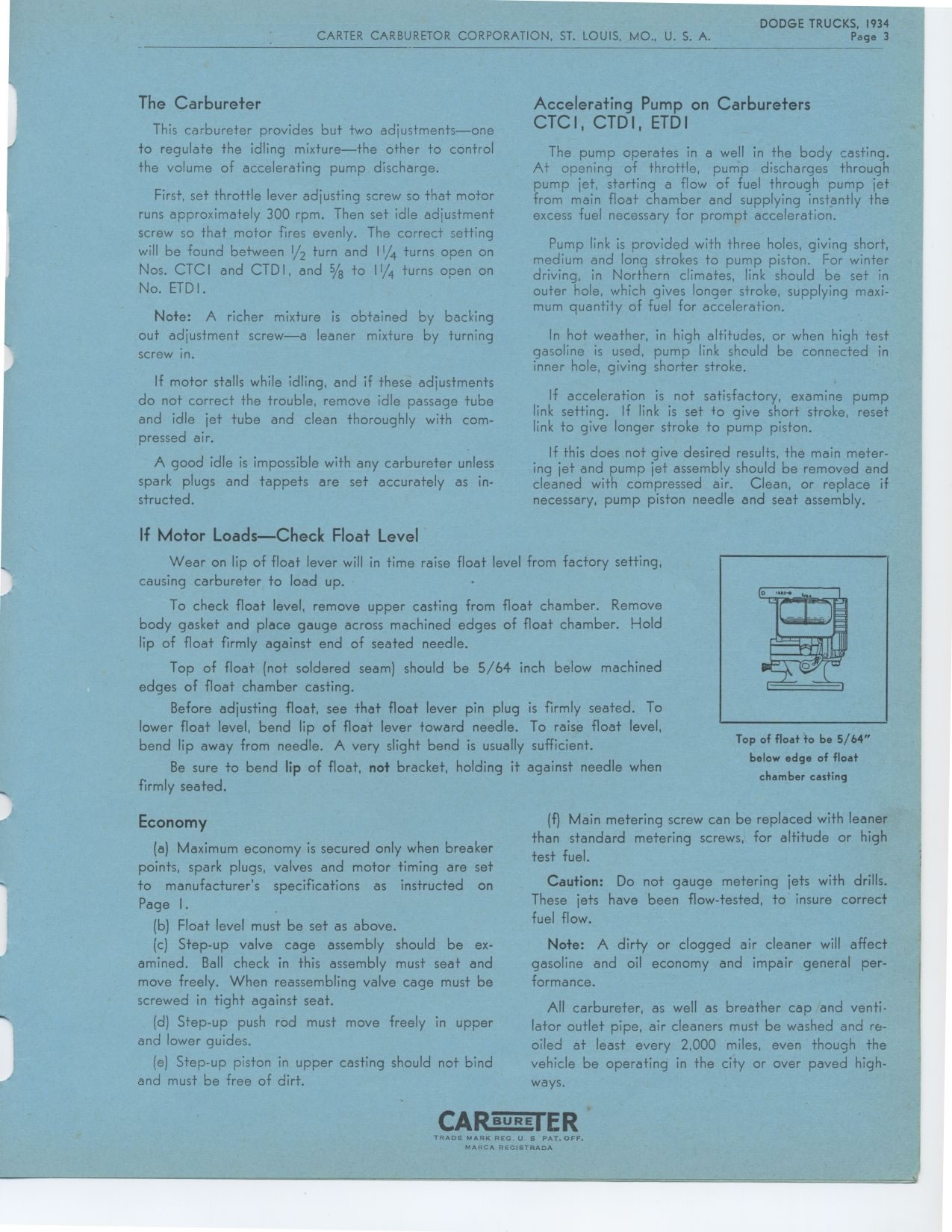Carburetors for old Dodge Trucks : DODGE TRUCKS 1934Previous | Home | Next |
 |
DODGE
TRUCKS, 1934 Page 3
The Carbureter
This carbureter provides but two adjustments—one to regulate the idling
mixture—the other to control the volume of accelerating pump discharge.
First, set throttle lever adjusting screw so that motor runs approximately
300 rpm. Then set idle adjustment screw so that motor fires evenly. The correct
setting will be found between 1/2 turn and 11/4 turns open on Nos. CTCI and
CTDI , and 5/8 to 11/4 turns open on No. ETDI .
Note: A richer mixture is obtained by backing out adjustment screw—a
leaner mixture by turning screw in.
If motor stalls while idling, and if these adjustments do not correct the trouble,
remove idle passage tube and idle jet tube and clean thoroughly with compressed
air.
A good idle is impossible with any carbureter unless spark plugs and tappets
are set accurately as instructed.
Accelerating Pump on Carbureters CTCI , CTDI , ETD I
The pump operates in a well in the body casting. At opening of throttle, pump discharges through pump jet, starting a flow of fuel through pump jet from main float chamber and supplying instantly the excess fuel necessary for prompt acceleration.
Pump link is provided with three holes, giving short, medium and long strokes to pump piston. For winter driving, in Northern climates, link should be set in outer hole, which gives longer stroke, supplying maxi-mum quantity of fuel for acceleration.
In hot weather, in high altitudes, or when high test gasoline is used, pump link should be connected in inner hole, giving shorter stroke.
If acceleration is not satisfactory, examine pump link setting. If link is
set to give short stroke, reset link to give longer stroke to pump piston.
If this does not give desired results, the main metering jet and pump jet assembly
should be removed and cleaned with compressed air. Clean, or replace if necessary,
pump piston needle and seat assembly.
If Motor Loads—Check Float Level
Wear on lip of float lever will in time raise float level from factory setting,
causing carbureter to load up.
To check float level, remove upper casting from float chamber. Remove body
gasket and place gauge across machined edges of float chamber. Hold lip of
float firmly against end of seated needle.
Top of float (not soldered seam) should be 5/64 inch below machined edges of
float chamber casting.
Before adjusting float, see that float lever pin plug is firmly seated. To
lower float level, bend lip of float lever toward needle. To raise float level,
bend lip away from needle. A very slight bend is usually sufficient.
Be sure to bend lip of float, not bracket, holding it against needle when firmly
seated.
Top of float to be 5/64"
below edge of float
chamber casting
Economy
(a) Maximum economy is secured only when breaker points, spark plugs, valves
and motor timing are set to manufacturer's specifications as instructed on
Page 1.
(b) Float level must be set as above.
(c) Step-up valve cage assembly should be examined. Ball check in this assembly
must seat and move freely. When reassembling valve cage must be screwed in
tight against seat.
(d) Step-up push rod must move freely in upper and lower guides.
(e) Step-up piston in upper casting should not bind and must be free of dirt.
(f) Main metering screw can be replaced with leaner than standard metering
screws, for altitude or high test fuel.
Caution: Do not gauge metering jets with drills. These jets have been flow-tested,
to insure correct fuel flow.
Note: A dirty or clogged air cleaner will affect gasoline and oil economy and
impair general performance.
All carbureter, as well as breather cap and ventilator outlet pipe, air cleaners
must be washed and re-oiled at least every 2,000 miles, even though the vehicle
be operating in the city or over paved high-ways.